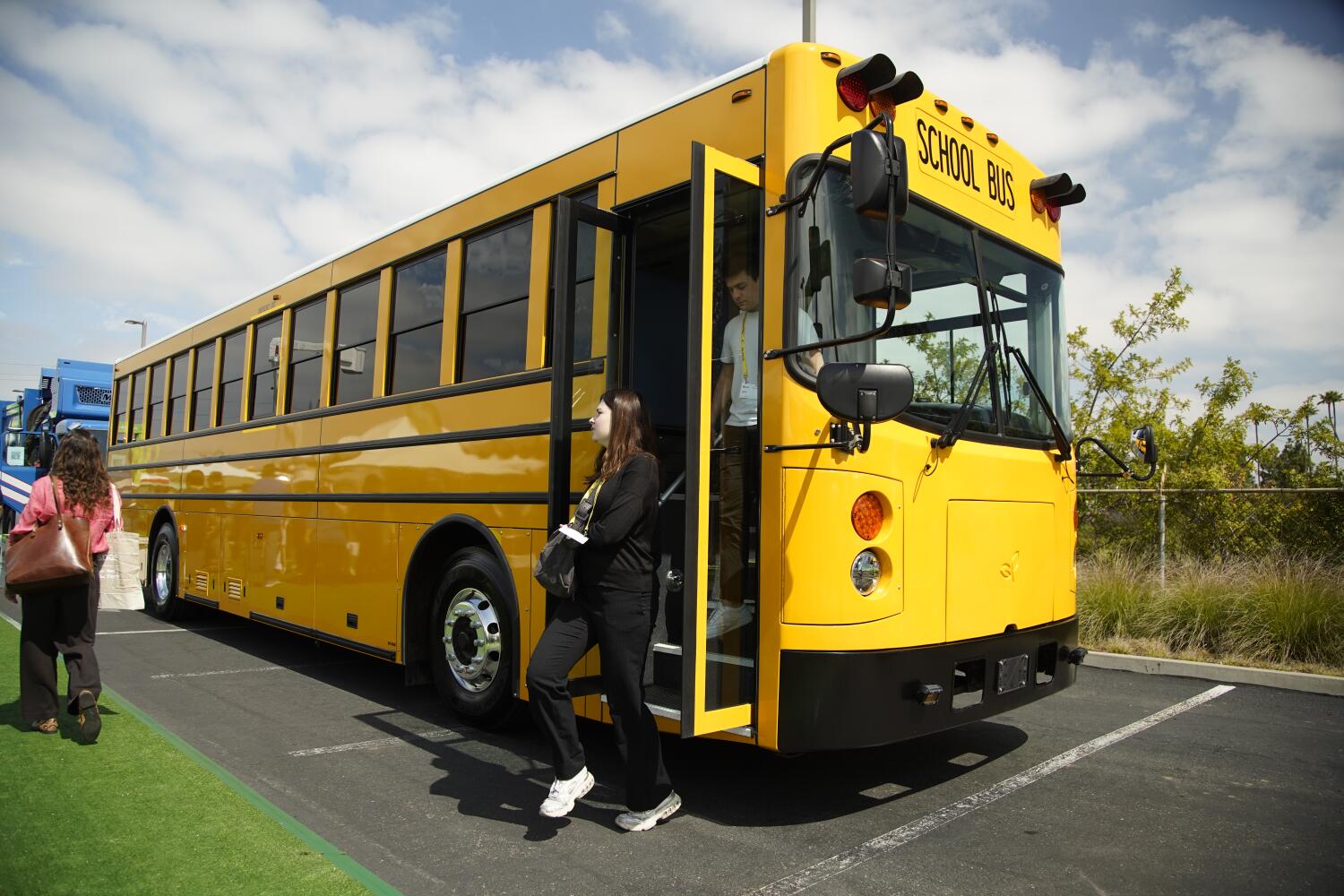By Rob Nikolewski | San Diego Union Tribune
California policymakers want to clean up the emissions spewed by the trucking industry — and they’ve passed mandates and established targets to get there.
The federal government recently followed up, creating its own set of national guidelines that are staggered by year and truck classification.
With California at the forefront, adoption is gaining ground among vehicles that travel around 200 miles or less per day — what’s called the short-haul sector that includes delivery vans, buses, etc.
But can big rigs traveling longer distances eventually complete the transition to zero-emissions at the pace the mandates laid down by California and the federal government require? It’s an open question.
“I think we’re still in the first half of the first inning when it comes to truck electrification, but it’s accelerating quickly,” said Lawren Markle, director of media relations for GNA, a Santa Monica consulting firm owned by TRC Companies that specializes in clean transportation and energy.
But the American Trucking Associations, an industry trade group, says the rules are moving too fast.
“The margins in the trucking industry are very, very slim — like 2 to 3 percent — so it’s a very competitive market as it is,” said Jacqueline Gelb, the trucking associations’ vice president of energy and environmental affairs. “So the fleet likely is not going to be able to wholly bear any type of increase in costs, and that will get passed on to the consumer.”
The mandates
California instituted its Advanced Clean Fleets, or ACF, rule at the start of this year. Among its provisions, the rule requires large fleet operators of more than 50 vehicles or $50 million in revenue to adopt zero-emissions medium- and heavy-duty vehicles.
Operators of what’s called “last-mile” delivery trucks and vans — that is, the final phase of moving a product from the back of truck to a customer’s doorstep — must convert at least 10 percent of their fleets to zero-emissions by next year.
A 50 percent zero-emissions requirement is already in effect for local government fleets.
All fleets will have to ramp up to 100 percent zero-emissions, with deadlines ranging from 2035 to 2042 based on individual vehicle types.
Some trucking groups have filed lawsuits challenging the ACF rule, and the California Air Resources Board is seeking a waiver from the federal government to resolve the debate about whether the state can implement the rule. A decision on the waiver has yet to be issued, but many fleets are moving forward on the assumption the ACF will stay in place.
Last month, the U.S. Environmental Protection Agency announced its greenhouse gas emission standards for heavy-duty vehicles. Known as Phase 3, the limits on carbon dioxide emissions become increasingly stringent each year from 2027 to 2032.
Industry experts believe it will be difficult for diesel-only truck sales to meet the EPA’s Phase 3 targets. Instead, manufacturers will likely need to sell a mix of low-emission technologies, which will likely increase prices of traditional diesel-powered vehicles.
What’s working now
San Diego Gas & Electric recently hosted its annual EV Fleet Day expo that showed off clean trucks, vans, buses and big rigs as well as electric vehicle charging projects.
Representatives of BrightDrop, a subsidiary of General Motors specializing in delivery vehicles, took visitors on tour of its 2024 all-electric Zevo 600.
Stretching 24 feet, the vehicle boasts a combined highway and city range of 272 miles, which works well for the stops that drivers make each day for companies like FedEx or Amazon.
“At 272 (miles), it makes a driver feel good that he can go out, crank the air conditioning, crank the heat,” said Christa Paterson, sales account executive at BrightDrop. “He’s not going to run out a battery in the middle of the city or on some freeway.”
When the delivery day is done, the vans can return to the company’s depot, get charged overnight when electricity rates are at their lowest and then get back on the road for another day of work.
All-electric vehicles are significantly quieter than diesel-powered vans, and while Paterson said the retail price of the 272-mile BrightDrop comes to about $105,000, state and federal rebates and incentives knock the price down considerably. She estimated GM has sold about 2,000 thus far in the U.S., Canada and Mexico.
The day before the expo, Paterson said she met a FedEx driver who raved about the technology in his BrightDrop van. “He probably came out of a FedEx van that was 20 years old — you know, with no backup cameras,” she said. “It’s like getting an iPhone 15 over an iPhone 4.”
Just a few feet away, GreenPower Motor Co. displayed its Type D battery-powered school bus that seats about 90 and touts 300 miles of range on a single charge.
“A school bus is actually one of the most opportune applications of electric technology,” said Mark Nestlen, vice president of business development and strategy for company based in Vancouver, British Columbia. “The majority of school bus routes in the United States are 80 miles or less. You have a set route; you know where the bus is going.”

Schools can save money on fueling costs, since electric charging is typically cheaper than diesel, and reduce expenses that come with upkeep.
“There are 150 less moving parts than you would have in a traditional school bus” using an internal combustion engine, Nestlen said. “So you obviously have significant reduction in maintenance costs. You don’t change oil in an electric school bus.”
The Grossmont Unified School District has GreenPower Motor school buses on the road, and other schools in the San Diego area are converting their fleets to zero-emissions.
Financial incentives
Battery-powered buses, vans and big rigs have retail price tags that are considerably higher than conventionally fueled vehicles.
But similar to inducements in the passenger car sector, government-funded programs greatly reduce the price of zero-emissions vehicles. When stacked up, the financial incentives can lead to price tags approaching or achieving parity to diesel-powered counterparts.
The most popular program for medium- and heavy-duty vehicles in California is the Hybrid and Zero-Emission Truck and Bus Voucher Incentive Project, called HVIP for short.
Discounts include up to $120,000 for school buses and garbage trucks, $85,000 for delivery vehicles, $120,000 for commercial trucks and as much as $240,000 for heavy-duty Class 8 trucks and tractor-trailers.
The federal government also offers tax credits of up to $40,000 for electric and fuel vehicles that weigh more than 14,000 pounds and $7,500 for vehicles weighing less than that amount.
Fleets typically work with distributors and utilities such as SDG&E to take advantage of the numerous federal, state and even municipally funded grants and pilot programs available to them.
The long-haul challenge
The range between charges is improving, even for heavy-duty trucks rumbling along the highway.
Volvo Trucks has been one of the early entrants in the electric truck market. One of the big rigs it showed off at the SDG&E outing was the six-battery pack VNR Electric that has a marketed range of 275 miles, depending on factors like payload, topography of the routes and weather.
That’s a pretty good distance but it doesn’t compare to a diesel rig that travels about 600 to 800 miles per day before needing to refuel.
The VNR Electric is built for regional haul, said Katy Link, Electromobility Regional Sales Manager for Volvo Trucks North America. “We don’t go in and say, you’re going to be able to take this across country.”
But such a vehicle can “100 percent” work for a trucking company that’s hauling goods from, say, San Diego to El Centro and back, according to Tracey Craik, regional sales director for TEC Equipment, a dealer and distributor for Volvo and Mack trucks.
“Electric cannot fit every segment of a carrier’s business,” Craik said. “When they go long range, full-battery electric is not going to be able to accomplish that.”
In addition to range, significant challenges include the fact that charging an electric truck can take hours — and time is critical for trucking companies to deliver their products ASAP.
And then there’s the issue of actually making sure that charging stations get built along the routes that truckers use. The lack of charging infrastructure already bedevils the market for EV passenger cars.
So, given the California and EPA mandates, how does the trucking industry transition to zero-emissions for goods traveling hundreds of miles through multiple states?
Volvo Trucks is taking a three-pronged approach.
“EV range is going to improve with time and battery technology is going to improve,” Link said.
Second, Volvo and other manufacturers are looking at rigs powered by hydrogen that can travel long distances.
Hydrogen fuel cell vehicles combine hydrogen and oxygen to produce electricity, which runs a motor. To fuel the vehicles, drivers pull up to a station similar to a conventional gas station and pump hydrogen into the tank. Filling up takes much less time than going to an EV charging station, and like EVs, hydrogen fuel cell vehicles emit no greenhouse gases.
There are issues to overcome, though, including access to supplies of hydrogen that is produced cleanly and a lack of fueling infrastructure.

The third option is using internal combustion engines that run on renewable fuel — be it clean hydrogen or diesel made from fats and oils, such as soybean oil or canola oil, which is processed to be chemically the same as petroleum diesel.
Volvo Trucks recently rolled out the latest version of its flagship VNL 860. “We’re constantly improving our diesel product to reduce emissions,” Link said.
Despite the long-term challenges, the California Air Resources Board is confident the state’s regulations will be met.
The state “is two years ahead of schedule of its zero-emissions truck targets,” Kate Lamb, information officer for the board, known as CARB for short, said in an email to the Union-Tribune.
A report from last October said manufacturers had already met their 2024 sales benchmarks, “showing market interest in zero-emissions technology.” Improved air quality will also help communities often surrounded by major highways and transportation facilities.
“The regulations are essential to achieving clean air needs and targets,” Lamb said.
Gelb of the American Trucking Associations is skeptical.
“There is a symbiotic relationship between the fleet and the manufacturer of how technology is developed, how it runs in the real world and sharing that information,” Gelb said. “California’s regulations have completely skipped that entire process … They are looking at it as a math problem: ‘I need to reduce this amount of emissions out of my state. How do I need to get there at the absolute fastest?’ ”
A study released earlier this year, which was commissioned by a coalition of trucking groups, estimated that full electrification of the U.S. commercial truck fleet would require nearly $1 trillion in infrastructure investments — $620 billion for chargers, site infrastructure and electric service upgrades and $370 million in upgrades from utilities to meet the demand of commercial vehicles.
On the other hand, an analysis from CARB estimated that fleet operators will see $48 billion in cost savings from 2020 through 2025 — not including public health benefits and incentive programs provided by the state.
This story originally appeared in San Diego Union-Tribune.







